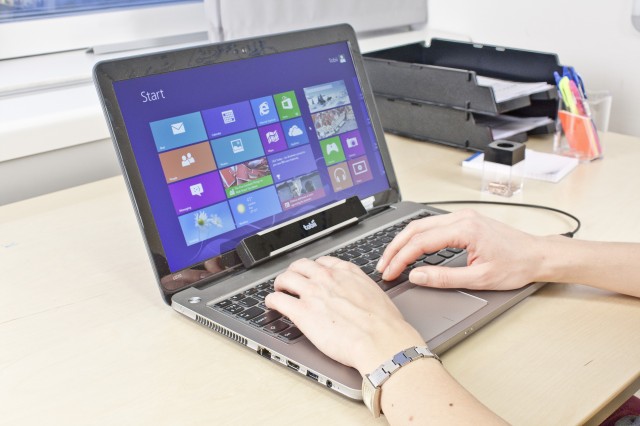
In Back to the Future's version of 2015, a couple of snot-nosed kids compare Wild Gunman to a "baby's toy" because "you have to use your hands." In recent years, new controllers like the Kinect have brought us closer to that imagined hands-free future. But even though you aren't holding anything, you still tend to end up waving your upper appendages in front of a camera. For true hands-free gaming, you're better off looking to the eye-tracking system Tobii is demonstrating at CES this week.
Unlike more general purpose camera systems, Tobii's gaze-trackers illuminate users' eyes with an infrared glint, then uses two sensors to take 30 frame-per-second images of that glint as it bounces off the back of the retina and the cornea. Using that data, the system can build a real time 3D model of a users' eye and track its position through three-dimensional space in order to accurately determine where the user is looking on the screen (after a one-time calibration).
Tobii has been making larger, more specialized gaze-trackers for about ten years, and has sold thousands of units for use primarily in the research community and to help aid the severely disabled. But the company is getting ready to make the leap into the consumer space with its latest device, the IS20, a USB peripheral that's less than seven inches wide and one inch tall. That's five times smaller than the version built into a laptop that was shown off at last year's CES. It's also much more energy efficient, working off just three watts of power.
At a pre-CES demo of the IS20, the creators showed off how the device could be used to quickly navigate a webpage as you scan it with your eyes, or to quickly zoom in on your home town in Google Maps. But what most interested me was an asteroid-destroying demo that was probably the first game I've ever played that didn't require me to use my hands, feet, or voice to play. Just holding my gaze on a moving asteroid for less than a second was enough to tell the game to send out a laser-pulse to shatter it into smaller pieces that ricocheted around the screen, as you can see in the video below.
The new control method required a bit of concentration, and the game's lack of on-screen cues made it a little difficult to understand why the system didn't always register my focused gaze. All in all, though, it was still a pretty incredible experience. Sitting still, with my hands at my side, and watching on-screen asteroids explode with just a glance was the closest thing to effective mind-controlled gaming that I've ever experienced.
A spokesman for Tobii sees gaming as one of the primary industries to make use of gaze-tracking on a commercial level, alongside computer-aided design, financial services and military applications. Developers like Zynga and Blizzard are already using Tobii hardware and software in their internal testing to help refine their interfaces by tracking where players are looking as they play games. As far as using a gaze-tracker as a dedicated game controller, Tobii has developed customized demos that use the feature to enhance games like Minecraft and Starcraft.
Tobii is reaching out to game makers as it begins to sell the $995 developer version of the IS20 and the company plans to put out a limited edition run of 5,000 consumer-grade devices in the fall, targeting professionals and "prosumer"-level computer users. Early on, the device will likely face the same chicken-and-egg problem as any new control peripheral: game developers don't want to invest resources to support a device no one has, and gamers don't want to buy a device that isn't supported by any game developers. But the spokesperson I talked to optimistically suggested a $21 million investment by Intel last year is helping catapult Tobii to a point where it could be built-in to practically every PC within two years time.
If that comes to pass, don't be too surprised if the "Controls" section of future gaming configuration screens starts including a "gaze tracker" tab alongside the now-standard "mouse/keyboard" and "gamepad" options.
Listing image by Dr Ioannis (Yiannis) Patras
reader comments
44